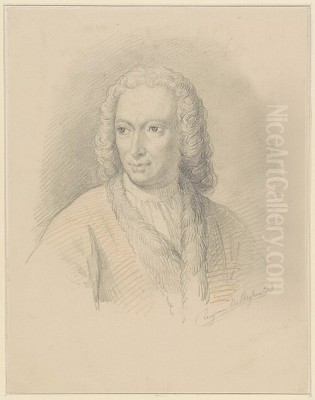
Meindert Hobbema stands as one of the most significant landscape painters of the Dutch Golden Age, a period of extraordinary artistic flourishing in the 17th-century Netherlands. Though his work was not widely celebrated during his lifetime, his reputation has grown considerably over the centuries. Today, he is often ranked second only to his teacher, the great Jacob van Ruisdael, among Dutch landscape artists. Hobbema's paintings, characterized by their serene depictions of woodlands, watermills, and sun-dappled country paths, offer an enduring vision of the Dutch countryside, rendered with remarkable technical skill and a distinct sensitivity to light and atmosphere.
Early Life and Artistic Beginnings
Born in Amsterdam on October 31, 1638, Meindert Hobbema was originally named Meindert Lubbertsz. His early life appears to have been marked by hardship. Following the death of his mother, the young Meindert, around the age of 15 in 1653, was placed in the municipal orphanage. It was likely during this period, or shortly thereafter, that his artistic talents began to emerge. By his late teens, he had embarked on the path that would define his life's work.
Crucially, around the mid-to-late 1650s, Hobbema became the apprentice of Jacob van Ruisdael, already an established and highly respected landscape painter. This apprenticeship, though perhaps lasting only a year or so in formal terms, forged a deep and lasting connection between the two artists. Ruisdael was not merely a teacher but also a friend and mentor, a relationship underscored by his role as a witness at Hobbema's wedding years later. The decision to change his surname to Hobbema, possibly the name of a family relative or place, occurred during his youth, marking a step towards establishing his own identity.
The Influence of Jacob van Ruisdael
The impact of Jacob van Ruisdael on Hobbema's early artistic development cannot be overstated. Ruisdael was a master of depicting the power and drama of nature, often favouring more imposing, sometimes melancholic or wild scenes, featuring dramatic skies, waterfalls, and ancient ruins. Hobbema's initial works clearly show his teacher's influence in terms of composition, the detailed rendering of foliage, and the overall approach to landscape structure.

However, even while absorbing Ruisdael's lessons, Hobbema began to cultivate his own distinct artistic personality. While Ruisdael often explored the sublime and untamed aspects of nature, Hobbema gravitated towards more peaceful, idyllic, and accessible rural scenes. His palette generally became brighter and warmer than his master's, and his handling of light more focused on gentle, pervasive sunlight filtering through leaves, creating a sense of tranquility rather than drama.
It's also worth noting the broader context of Dutch landscape painting. Hobbema worked alongside contemporaries who explored different facets of the Dutch environment. Artists like Jan van Goyen and Salomon van Ruysdael (Jacob's uncle) were pioneers of the "tonal phase," emphasizing atmospheric effects through a limited palette. Others, like Aelbert Cuyp, became famous for their luminous depictions of the Dutch landscape, often featuring cattle bathed in a golden Mediterranean light, quite different from Hobbema's typical woodland scenes. Hobbema carved his niche within this rich tradition.
Development of a Unique Style
By the 1660s, Hobbema had fully matured as an artist, developing a signature style that distinguished him from his contemporaries, including Ruisdael. His preferred subjects became the wooded landscapes of the eastern Netherlands, particularly the regions of Gelderland and Overijssel, near the German border, though he primarily worked in and around Amsterdam. He excelled in depicting the intricate play of light and shadow beneath canopies of trees, often focusing on oak trees rendered with meticulous attention to the texture of bark and the delicate structure of leaves.
Hobbema's compositions are typically well-ordered and harmonious, often featuring a path or stream leading the viewer's eye into the depth of the scene. He employed precise linear perspective to create a convincing sense of space, arranging trees, cottages, and figures within a carefully constructed framework. Unlike the often dramatic or emotionally charged landscapes of Ruisdael, Hobbema's scenes usually evoke a sense of calm, stability, and the quiet rhythms of rural life.
His treatment of light is perhaps his most defining characteristic. He masterfully captured the effect of sunlight breaking through clouds or filtering through dense foliage, creating patterns of bright highlights and cool shadows on the ground and tree trunks. This use of light lends his paintings a sparkling clarity and vibrancy, contributing significantly to their cheerful and inviting atmosphere. His skies are often filled with puffy white clouds against a blue expanse, reinforcing the overall feeling of a pleasant day in the countryside.
Key Themes and Motifs
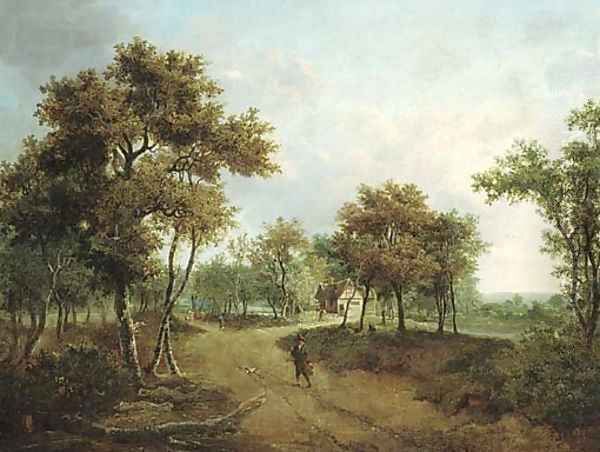
Throughout his most productive period, primarily the 1660s, Hobbema returned repeatedly to certain themes and motifs, exploring them with subtle variations. Woodlands were a constant subject, depicted not as impenetrable wilderness but as managed, accessible spaces, often interspersed with cottages, figures, and signs of human activity. These scenes convey an idealized harmony between humanity and nature.
Watermills became one of Hobbema's most iconic subjects. While he wasn't the first Dutch artist to paint watermills, he made the theme distinctively his own. He painted numerous variations, often depicting picturesque, sometimes slightly dilapidated mills nestled among trees beside tranquil water. These watermill paintings showcase his technical skill in rendering architecture, water reflections, and foliage. Some interpretations suggest these scenes carry a deeper meaning, perhaps reflecting on the passage of time, the cycles of nature, or the quiet industry sustaining rural life. The gentle turning of the mill wheel could be seen as a metaphor for life's steady, ongoing rhythm.
Country roads and paths are another recurring feature, winding through forests or fields, often populated by travellers or peasants. These elements serve both as compositional devices, leading the eye into the landscape, and as narrative hints, suggesting journeys and the connections between different parts of the rural community. The figures in his landscapes are typically small, integrated harmoniously into the setting rather than dominating it, emphasizing the primacy of nature.
Masterworks: Defining Canvases
Several paintings stand out as quintessential examples of Hobbema's artistry and represent the peak of his achievement.
_The Avenue at Middelharnis_ (1689, National Gallery, London) is arguably Hobbema's most famous painting and a landmark of Dutch art. Painted late in his career, after a period of reduced artistic output, it is remarkable for its striking composition and masterful handling of perspective. The painting depicts a long, straight road flanked by unnaturally tall, slender poplar trees, receding dramatically towards a distant village under a wide sky. The rigid symmetry and exaggerated perspective create a powerful, almost surreal effect. It beautifully captures the flat landscape of the region and the interplay of light and shadow across the road and fields. The work is often discussed for its unique composition and its possible commentary on human intervention in the landscape – the cultivated trees lining the man-made road.
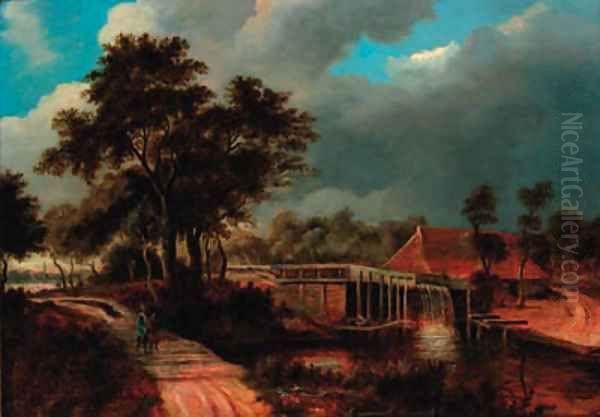
_The Ruins of Brederode Castle_ (1671, National Gallery, London) showcases Hobbema's ability to incorporate architectural elements into his landscapes. While ruins were a more common theme for Jacob van Ruisdael, Hobbema here offers his own interpretation. The crumbling castle walls are bathed in sunlight, surrounded by lush vegetation and water. The scene balances the romantic appeal of the ruin with Hobbema's characteristic clarity and detailed observation of nature, creating a picturesque rather than purely melancholic image.
_Watermills_: Hobbema painted many watermills, and several are considered masterpieces. _The Watermill_ (c. 1664, Rijksmuseum, Amsterdam) and _The Watermill at Singraven near Denekamp_ (c. 1665, Rijksmuseum, Amsterdam) are excellent examples. These works demonstrate his fascination with the subject, capturing the interplay of the wooden structure, the surrounding trees, the reflective water, and the gentle light. They epitomize the peaceful, rustic charm that defines much of his oeuvre. Another notable work is _A Watermill_ found in The Wallace Collection, London.
_Wooded Landscapes_: Numerous paintings fall under this category, representing the core of his work. _A Wooded Landscape with a Road_ and _A Road among Trees_ exemplify his skill in creating inviting forest interiors. _A Woodland Scene with Travelers_ is considered by some to represent the height of his powers in rendering complex foliage and light effects within a forest setting. _A Farm in the Sunlight_ (1668, National Gallery of Art, Washington D.C.) perfectly captures the idyllic atmosphere of a sunny rural homestead nestled amongst trees.
_The Haarlem Lock, Amsterdam_ (c. 1663-65, Rijksmuseum, Amsterdam) shows his ability to handle scenes involving more complex water management structures, again integrating human elements seamlessly into the natural environment. These works collectively demonstrate Hobbema's consistent vision and technical brilliance during his prime years.
Later Career and Life Circumstances
In 1668, a significant event occurred in Hobbema's personal life: he married Eeltje Vinck van Gorcum, a kitchen maid who had worked for the burgomaster Lambert Reynst. Jacob van Ruisdael served as a witness at the wedding ceremony in the Oude Kerk (Old Church) in Amsterdam, testifying to their enduring friendship. Eeltje already had children from a previous relationship, and together she and Meindert would have more.
Shortly after his marriage, in November 1668, Hobbema secured a position that would dramatically alter his life and, seemingly, his artistic output. He was appointed as one of the wine gaugers for the Amsterdam octroi (municipal customs), a reasonably well-paid civic job that involved measuring the contents of wine casks to assess taxes. This position provided financial stability, something that had likely eluded him as a painter in the competitive Amsterdam art market.
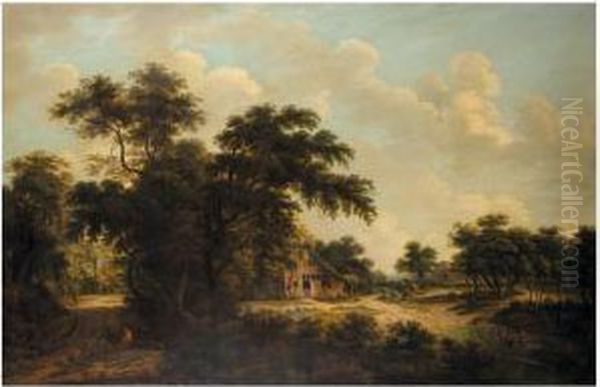
Conventional art historical narratives often suggest that Hobbema largely abandoned painting after taking this post. However, the existence of his most famous work, The Avenue at Middelharnis, dated 1689, clearly indicates that he did continue to paint, albeit perhaps less prolifically. It remains a point of discussion why his output seems to have diminished during the years he held the gauger position. Perhaps the demands of the job left less time for art, or perhaps the financial security lessened the urgency to produce works for sale.
Despite the security his job provided, Hobbema's later life was not without hardship. His wife predeceased him in 1704. When Hobbema himself died on December 7, 1709, he was living in relative poverty on the Rozengracht in Amsterdam, a street where Rembrandt van Rijn had also spent his final years in similarly reduced circumstances. Hobbema was buried in the Westerkerk cemetery in Amsterdam. His apparent poverty at the end of his life suggests that neither his art nor his civic post had provided lasting wealth, reflecting the often precarious financial situation of artists, even talented ones, during the Dutch Golden Age.
Posthumous Reputation and Influence
During his lifetime and for several decades after his death, Meindert Hobbema remained relatively obscure compared to his teacher Ruisdael or other leading Dutch masters. His paintings were not widely sought after by Dutch collectors. However, his fortunes began to change significantly in the later 18th and especially the 19th century, primarily due to growing appreciation in Britain and France.
British collectors and artists, in particular, developed a strong affinity for Hobbema's work. His serene, detailed, and light-filled depictions of manageable, picturesque nature resonated with the developing tastes for landscape painting in Britain. His influence can be clearly seen in the work of major figures of the British landscape school. Thomas Gainsborough, though an earlier contemporary, shared a similar feathery touch in rendering foliage. John Constable deeply admired Hobbema, and the influence is evident in Constable's own depictions of the English countryside, particularly his detailed studies of trees and his focus on the effects of light. J.M.W. Turner, while moving towards a more dramatic and abstract style, also learned from the Dutch landscape tradition Hobbema represented.
In France, Hobbema's work was appreciated by artists associated with the Barbizon School, such as Théodore Rousseau and Charles-François Daubigny, who sought a return to direct observation of nature and found inspiration in the naturalism and atmospheric sensitivity of Dutch 17th-century landscapes. Hobbema's paintings became prized possessions in major collections and fetched increasingly high prices at auction throughout the 19th century.
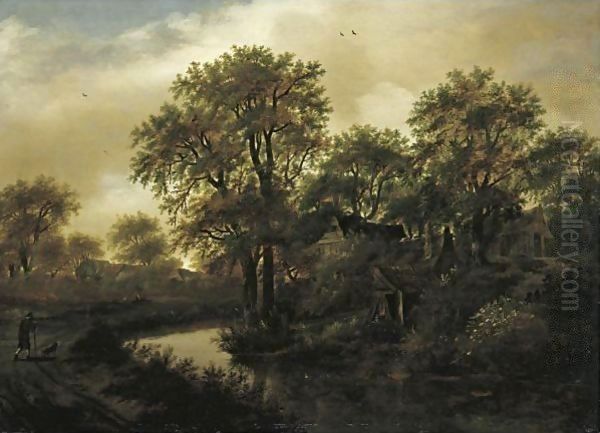
This posthumous rise in stature cemented Hobbema's place in the canon of Western art. He came to be seen as a key figure in the Dutch landscape tradition, representing a gentler, more idyllic counterpoint to the sometimes more dramatic or melancholic vision of Jacob van Ruisdael. His work was praised for its technical mastery, its charming subject matter, and its sensitive rendering of light and atmosphere.
Art Historical Significance
Meindert Hobbema's significance in art history lies in his contribution to the rich tapestry of Dutch Golden Age landscape painting. He perfected a particular type of landscape – the peaceful, sunlit woodland scene, often featuring watermills or cottages – which offered an idealized yet recognizable vision of the Dutch countryside. While influenced by Jacob van Ruisdael, he developed a distinct personal style characterized by a brighter palette, a focus on tranquil atmosphere, and meticulous attention to detail, particularly in the rendering of trees and foliage.
His work represents a specific aspect of the Dutch relationship with their environment – not the struggle against the sea or the grandeur of panoramic vistas (as seen in the work of Philips Koninck, for example), but the appreciation of intimate, cultivated, and habitable nature. His paintings celebrate the quiet beauty of the everyday rural world.
Though overshadowed by Ruisdael during his lifetime and for some time after, his eventual recognition, particularly in Britain, highlights the enduring appeal of his style. He became an important model for subsequent generations of landscape painters, demonstrating how careful observation, technical skill, and a sensitivity to light could be combined to create deeply satisfying and emotionally resonant images of nature. Today, he is firmly established as one of the leading masters of the genre, his works admired for their peaceful beauty and technical finesse.
Modern Study and Appreciation
In the 20th and 21st centuries, art historians have continued to study Hobbema's life and work, refining our understanding of his development, chronology, and place within the Dutch Golden Age. Research has clarified his relationship with Jacob van Ruisdael and explored the specifics of his technique and thematic concerns.
Attribution remains an area of interest. As with many artists of the period, works were sometimes misattributed. For instance, paintings by artists like Cornelis Decker, who worked in a similar style, have occasionally been confused with Hobbema's. Ongoing connoisseurship and technical analysis help to clarify the boundaries of his oeuvre.
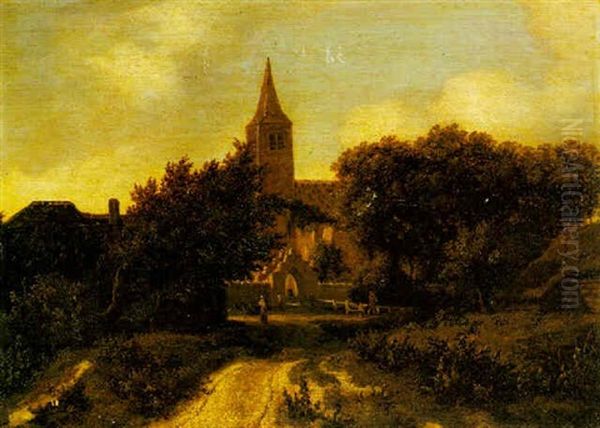
Today, Meindert Hobbema's paintings are held in major museums across the world, including the Rijksmuseum in Amsterdam, the National Gallery in London, the Wallace Collection in London, the Metropolitan Museum of Art in New York, and the National Gallery of Art in Washington D.C., among many others. Exhibitions featuring his work continue to draw audiences, allowing contemporary viewers to appreciate the serene beauty and masterful technique of this important Dutch landscape painter. His works remain popular, admired for their technical brilliance and their evocation of a peaceful, harmonious vision of the natural world.
Conclusion: An Enduring Vision of Tranquility
Meindert Hobbema's journey from an Amsterdam orphanage to becoming one of the most cherished landscape painters of the Dutch Golden Age is a testament to his talent and dedication. Though he faced financial struggles and his fame largely blossomed only after his death, his artistic legacy is secure. His paintings, particularly his iconic woodland scenes and watermills, offer a distinctive vision of the Dutch countryside – one characterized by tranquility, harmony, and a masterful handling of light. He captured the quiet beauty of rural life with a clarity and charm that continues to resonate with viewers centuries later. Alongside his teacher Jacob van Ruisdael and contemporaries like Vermeer and Rembrandt who explored different genres, Hobbema remains a vital figure in understanding the extraordinary artistic achievements of the 17th-century Netherlands, his canvases providing enduring windows onto a peaceful, sunlit world.